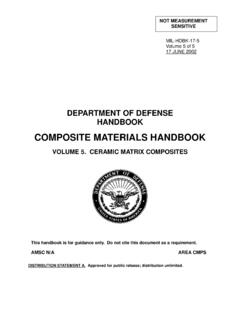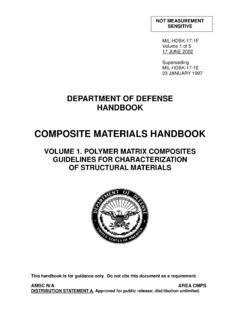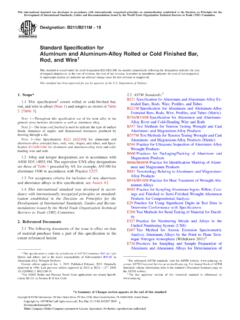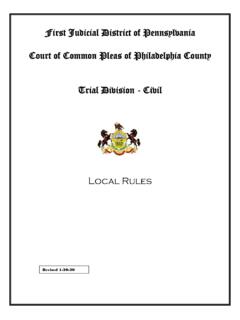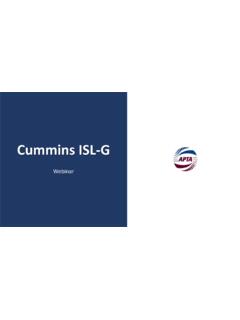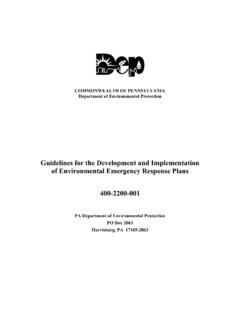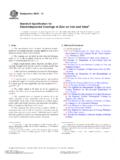Transcription of DEPARTMENT OF DEFENSE HANDBOOK - University of …
1 NOT MEASUREMENT SENSITIVE MIL-HDBK-17-3F Volume 3 of 5 17 JUNE 2002 Superseding MIL-HDBK-17-3E 23 JANUARY 1997 DEPARTMENT OF DEFENSE HANDBOOK COMPOSITE MATERIALS HANDBOOK VOLUME 3.
2 POLYMER MATRIX COMPOSITES MATERIALS USAGE, DESIGN, AND ANALYSIS This HANDBOOK is for guidance only. Do not cite this document as a requirement. AMSC N/A AREA CMPS DISTRIBUTION STATEMENT A. Approved for public release; distribution unlimited. MIL-HDBK-17-3F Volume 3, Foreword / Table of Contents ii FOREWORD 1. This Composite Materials HANDBOOK Series, MIL-HDBK-17, are approved for use by all Departments and Agencies of the DEPARTMENT of DEFENSE . 2. This HANDBOOK is for guidance only. This HANDBOOK cannot be cited as a requirement. If it is, the con-tractor does not have to comply. This mandate is a DoD requirement only; it is not applicable to the Federal Aviation Administration (FAA) or other government agencies.
3 3. Every effort has been made to reflect the latest information on polymer (organic), metal, and ceramic composites. The HANDBOOK is continually reviewed and revised to ensure its completeness and cur-rentness. Documentation for the secretariat should be directed to: Materials Sciences Corporation, MIL-HDBK-17 Secretariat, 500 Office Center Drive, Suite 250, Fort Washington, PA 19034. 4. MIL-HDBK-17 provides guidelines and material properties for polymer (organic), metal, and ceramic matrix composite materials. The first three volumes of this HANDBOOK currently focus on, but are not limited to, polymeric composites intended for aircraft and aerospace vehicles.
4 Metal matrix compos-ites (MMC) and ceramic matrix composites (CMC), including carbon-carbon composites (C-C) are covered in Volume 4 and Volume 5 , respectively. 5. This standardization HANDBOOK has been developed and is being maintained as a joint effort of the DEPARTMENT of DEFENSE and the Federal Aviation Administration. 6. The information contained in this HANDBOOK was obtained from materials producers, industry, reports on Government sponsored research, the open literature, and by contact with research laboratories and those who participate in the MIL-HDBK-17 coordination activity. 7. All information and data contained in this HANDBOOK have been coordinated with industry and the Army, Navy, Air Force, NASA, and Federal Aviation Administration prior to publication.
5 8. Copies of this document and revisions thereto may be obtained from the Document Automation and Production Service (DAPS), Bldg. 4D (DODSSP/ASSIST), 700 Robbins Avenue, philadelphia , PA 19111-5094. 9. Beneficial comments (recommendations, additions, deletions) and any pertinent data which may be of use in improving this document should be addressed to: Army Research Laboratory, Weapons and Materials Research Directorate, Attn: AMSRL-WM-MA, Aberdeen Proving Ground, MD 21005-5069, by using the Standardization Document Improvement Proposal (DD Form 1426) appearing at the end of this document or by letter. MIL-HDBK-17-3F Volume 3, Foreword / Table of Contents iii CONTENTS Foreword.
6 Ii Summary of Changes .. xvii CHAPTER 1 GENERAL INFORMATION .. 1 1 PURPOSE, SCOPE, AND ORGANIZATION OF VOLUME 3 .. 1 SYMBOLS, ABBREVIATIONS, AND SYSTEMS OF 2 Symbols and 2 Constituent 7 Laminae and laminates .. 8 Subscripts .. 9 Superscripts .. 10 Acronyms .. 10 System of units .. 12 13 CHAPTER 2 MATERIALS AND PROCESSES - THE EFFECTS OF VARIABILITY ON COMPOSITE PROPERTIES 1 1 1 1 CONSTITUENT MATERIALS .. 1 Fibers .. 1 Carbon and graphite fibers .. 1 Carbon vs. 2 General material description.
7 4 Processing .. 4 Typical properties .. 6 Aramid .. 6 Chemical 8 Physical forms available .. 9 Advantages and disadvantages .. 12 Common manufacture methods and 14 Boron .. 15 Alumina .. 17 Silicon carbide .. 19 Quartz .. 21 Ultrahigh molecular weight polyethylene.. 26 Resins .. 29 Overview .. 29 Epoxy .. 30 Polyester (thermosetting) .. 30 Phenolic .. 30 Resoles .. 31 Novolacs .. 31 Bismaleimide .. 31 32 Thermoplastic materials .. 32 MIL-HDBK-17-3F Volume 3, Foreword / Table of Contents iv 32 34 Specialty and emerging resin systems.
8 36 36 PROCESSING OF PRODUCT FORMS .. 36 Fabrics and Woven fabrics .. 36 Conventional woven fabrics .. 36 Stitched or knitted 38 Specialty fabrics .. 38 Preimpregnated forms .. 38 Prepreg roving .. 38 Prepreg tape .. 38 Conventional unidirectional tapes .. 38 Two-step unidirectional tapes .. 39 Supported unidirectional tapes .. 39 Coated unidirectional tapes .. 39 Preplied unidirectional 39 Prepreg fabric .. 39 Preconsolidated thermoplastic 39 SHIPPING AND STORAGE PROCESSES.
9 40 Packaging .. 40 Shipping .. 40 Unpackaging and storage .. 40 CONSTRUCTION 40 Hand 40 Automated tape placement/automated tape lamination .. 41 41 Benefits/capabilities .. 41 Sources of 41 Automated tow placement/fiber placement .. 42 42 Fiber placement process flow .. 43 Benefits/capabilities .. 43 Material product forms .. 44 Special considerations .. 45 47 Filament winding .. 48 Pultrusion .. 49 Sandwich construction .. 49 Adhesive bonding .. 50 Prebond moisture.
10 52 CURE AND CONSOLIDATION PROCESSES .. 52 Vacuum bag molding .. 52 Oven cure .. 53 Autoclave curing 53 General 53 Sources of 54 Press molding .. 54 Integrally heated 54 Pultrusion die cure and consolidation .. 55 Resin transfer molding (RTM).. 55 Thermoforming .. 58 ASSEMBLY 58 PROCESS CONTROL .. 59 Common process control schemes .. 59 MIL-HDBK-17-3F Volume 3, Foreword / Table of Contents v Empirical methods .. 59 Active sensor-based control .. 59 Passive model-based control .. 59 Example - autoclave cure of a thermoset composite.
